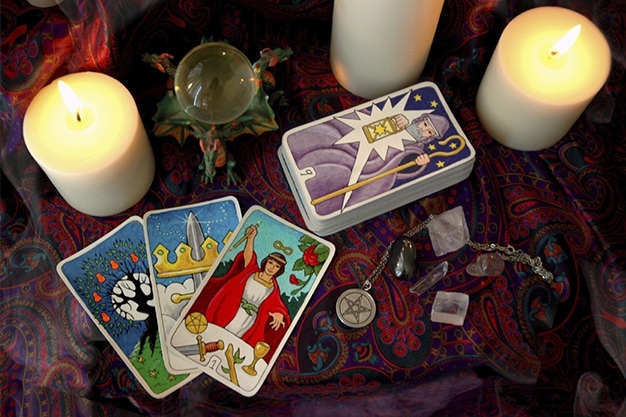
Many people have seen or encountered a tarot card, even if they didn’t recognize it at the time, but fewer understand the mystery and allure of this tradition. Around the early 1400s, tarot cards were used simply for card games. This pastime was limited to the wealthy, as each of the 78 cards in a deck had to be hand-painted. With the invention of the printing press, tarot was opened to everyone. For most tarot readings, only 22 of the cards, known as the Major Arcana, are used.
Picking a Deck
Choosing a deck is a unique experience for every tarot reader. Different decks will assign different images to the same core tarot card. One of the most commonly used decks, and a popular starter deck, is the Rider-Waite deck. The Rider-Waite deck was created in 1910. Its classic imagery is a great way to get acquainted with the cards. As a reader becomes more confident, they may want to look for a deck that is more personal and comfortable to work with.
When shopping for a personal deck, take the time to explore. A good deck should have tarot card images that allow the reader to discern specific meanings from each one. Some readers favor abstract imagery, while others are drawn to more traditional illustrations. The deck should fit your hand comfortably and be easy to shuffle. If the deck will be used regularly for readings, it’s important to pay attention to the quality of the cards. Good, firm card stock will enable use for many years.
Picking a Setting
Tarot has no specific rules to follow, which can be both freeing and frustrating. Readings can be performed anywhere. Many readers prefer a calm, quiet, meditative space of some kind. Clearer connections can be drawn if there are no distractions for either the reader or the questioner.
Card Meanings
Each tarot card has a different meaning or character. The Major Arcana consists of cards without any suit or number. The meaning of a specific card can change depending on whether it’s presented in an upright or reversed direction. The Fool, in an upright position, represents innocence and freedom of spirit. In a reversed position, it takes on a more negative connotation, suggesting naivety or foolishness.
The remaining cards, which make up the Minor Arcana, belong to four main suits: cups, pentacles, swords, and wands. Each suit corresponds to a specific element, which in turn has a distinctive association. The cups suit is linked to water, the pentacles to earth, swords to air, and wands to fire. Each suit has cards numbered one to ten and four court cards.
Many practitioners find it helpful to memorize the essential nature of each number according to the art of numerology, which can then be applied across the suits in tandem with the represented element. For example, the number one represents a new start, idea, or inspiration. The ace of cups can represent new love, creativity, or an abundance of emotion. The ace of pentacles, however, veers away from the emotional to evoke the idea of new opportunities for financial gain and new energy to pursue career goals.
All of the nuanced meanings the cards may imply can be overwhelming to new readers. As you start out, keep the meanings simple. Focus on the core trait of each card, and let connections naturally form. Successfully acquainting oneself with the cards and their meanings takes time and practice. Go slowly and enjoy the journey.
The Reading
A spread is a certain arrangement of tarot cards during a reading. One of the more complex iterations is the Celtic Cross. In this spread, ten cards are laid out, each with different meanings and relations to one another and to the questioner. Another spread, called the Tetraktys, uses ten cards arranged in the shape of a pyramid. The spread used is often determined by the type of reading being performed.
Beginners may find it more comfortable to begin with simple spreads. In these spreads, three or fewer cards are drawn to answer a simple question. One spread may include cards representing an individual’s past, present, and future. Another will use the cards to address aspects of a certain situation, such as what the individual thinks of the situation, what they feel about it, and what action they should take.
When beginning a reading, the most important thing to remember is to relax. Deep breaths will help clear the mind and rid the body of tense energy. Both the reader and questioner should approach the reading with an open, thoughtful mindset. Remember that tarot cards are not for predictions or the telling of fortunes. They are a tool to help clarify what already is and determine what needs additional attention.
Questions will inevitably be personal in nature. Readers have an ethical responsibility to the questioner to keep personal information secret. Treat the questioner and their concerns with kindness and respect. A tarot card reading can be a deeply touching experience for all involved parties. With time, patience, and practice, reading the cards will truly feel like second nature.
- The Tarot Realm: History
- The Magic of Tarot
- Symbolism Within the Tarot (PDF)
- The Fool and His Journey: Tarot Cards
- The Phenomenology of Tarot (PDF)
- The Occult Tarot and Mythology (PDF)
- Cosmic Spreads in Tarot
- The Rider-Waite Tarot Deck
- Tarot Reading Can Be Spiritual, Supportive, or Psychological
- Numerical Archetypes in Tarot Cards
- American Tarot Association
Article approved by Sophia Loren.

